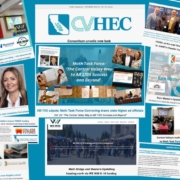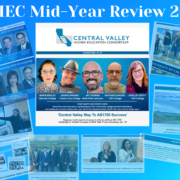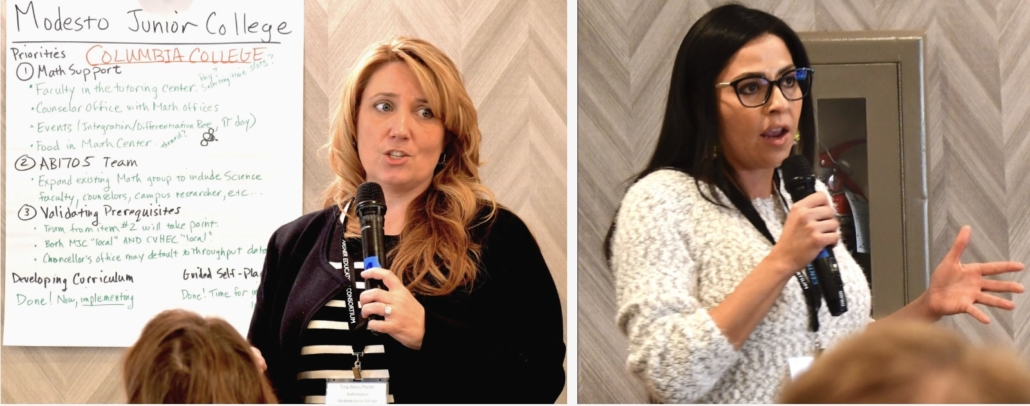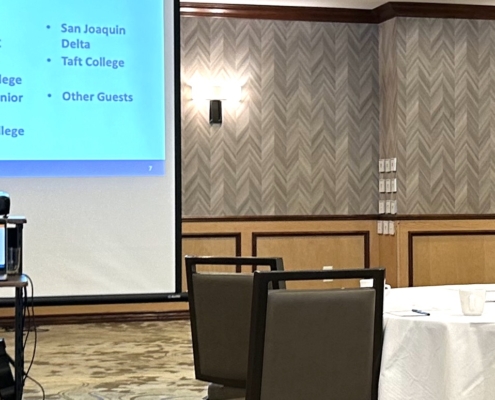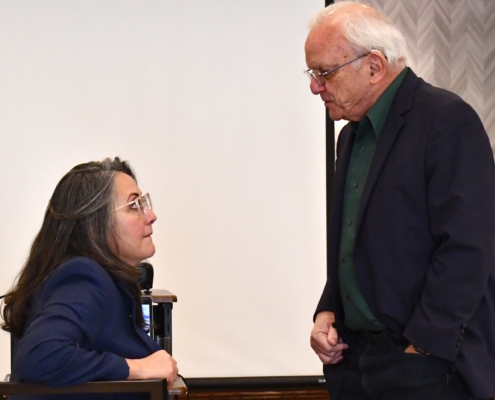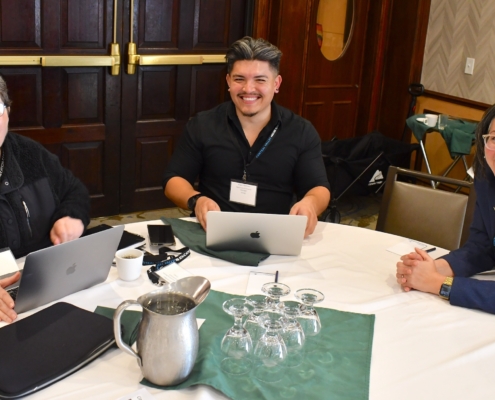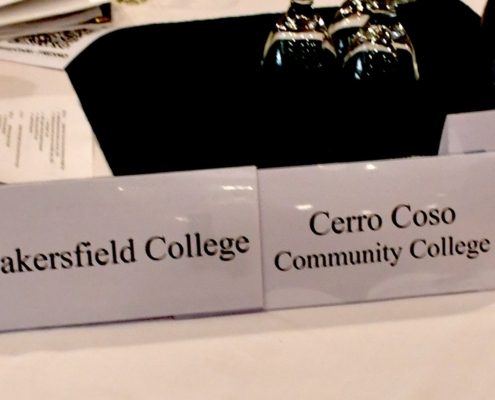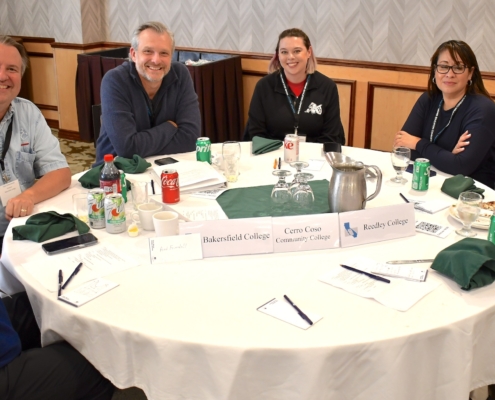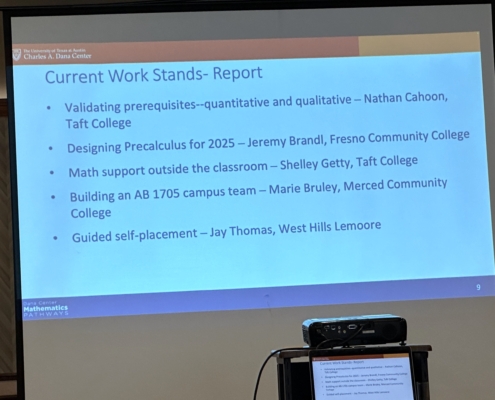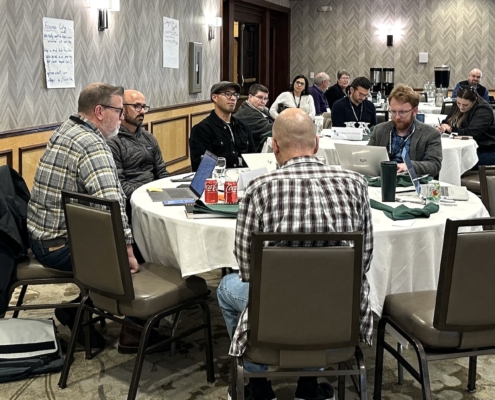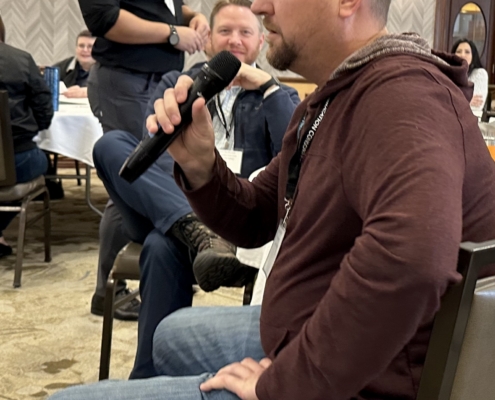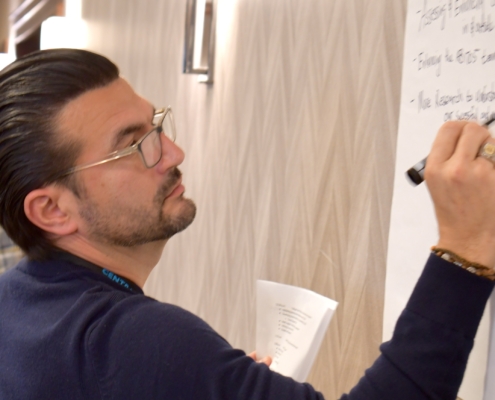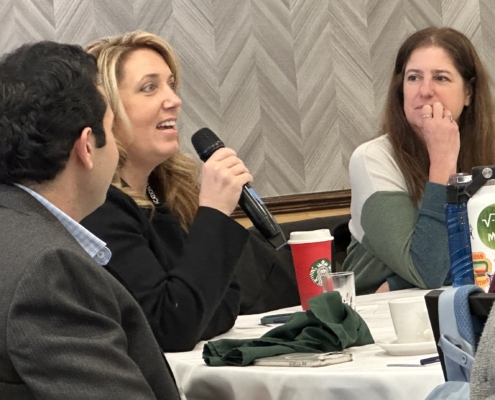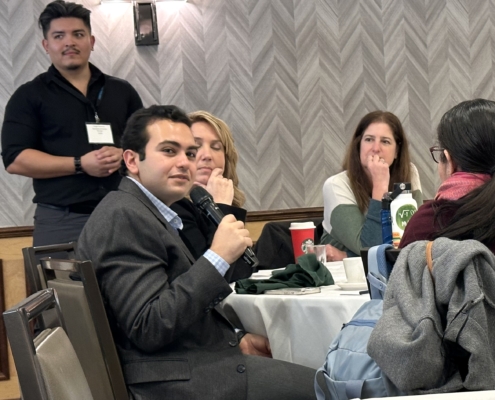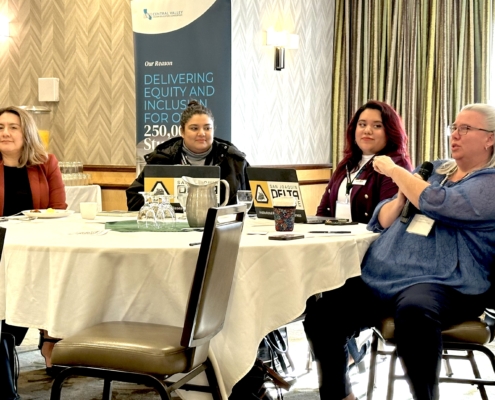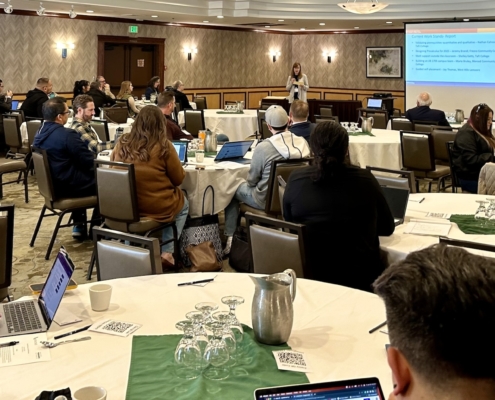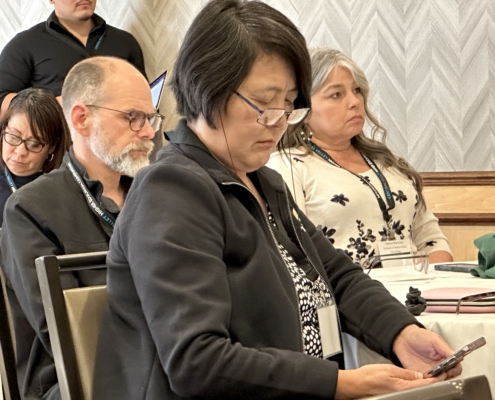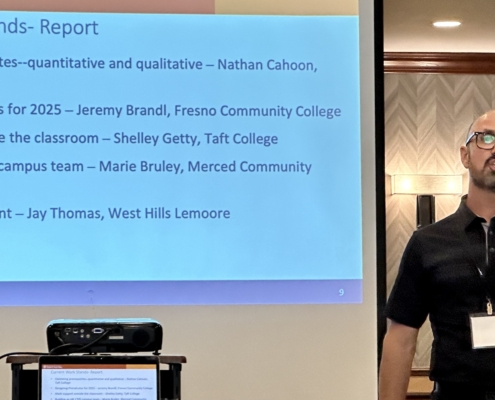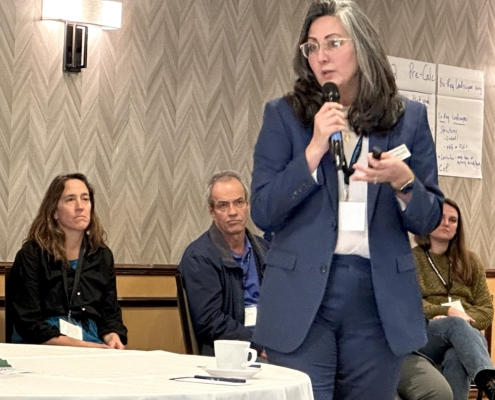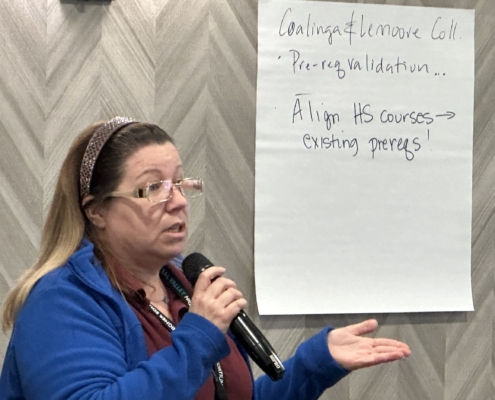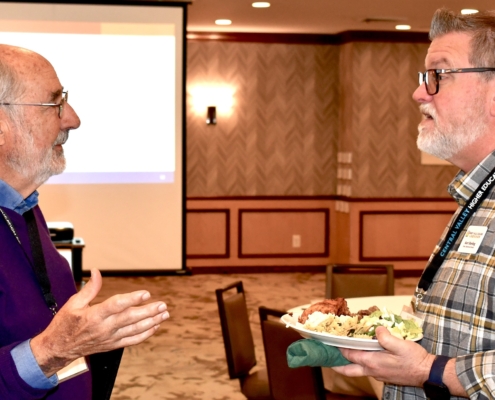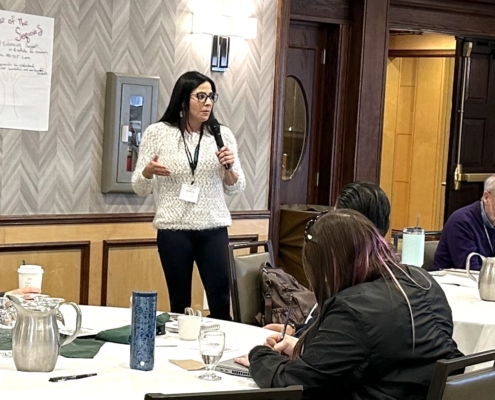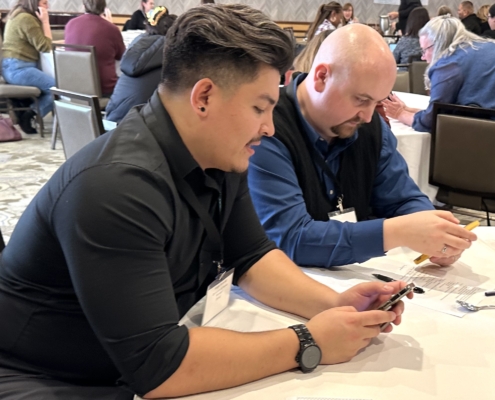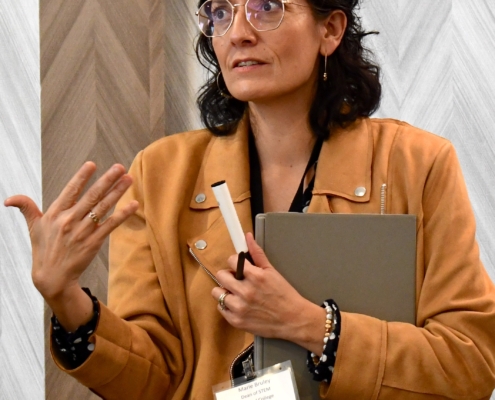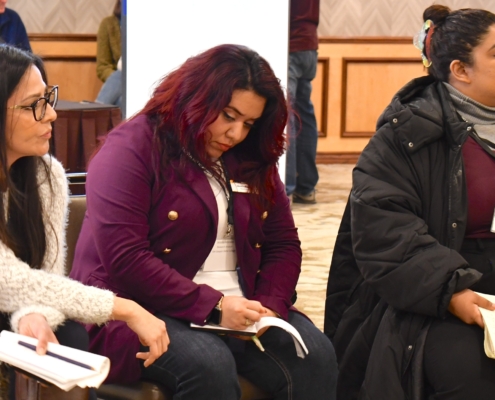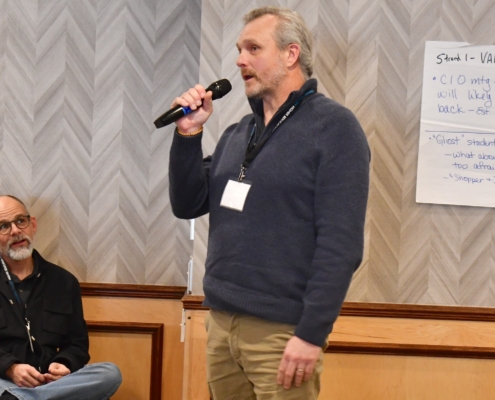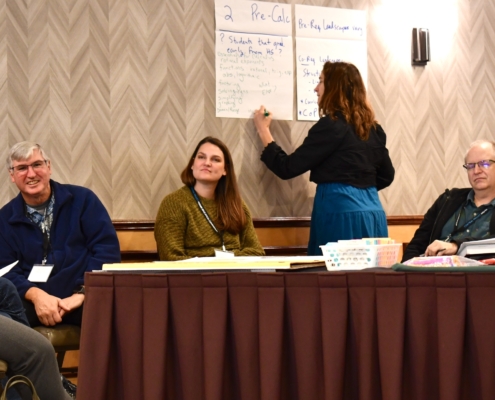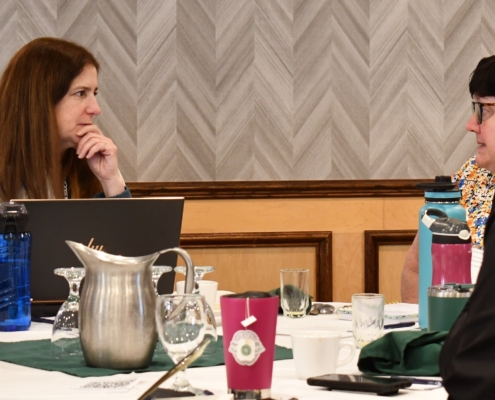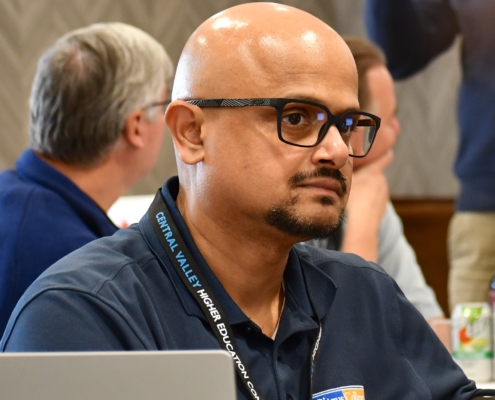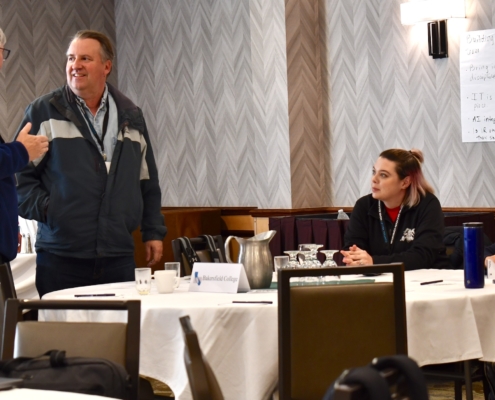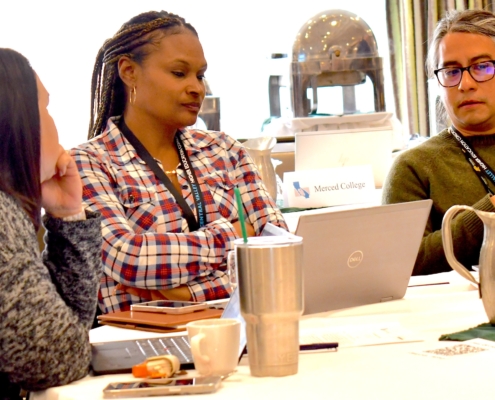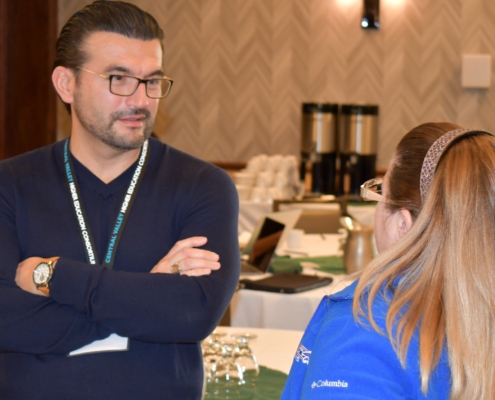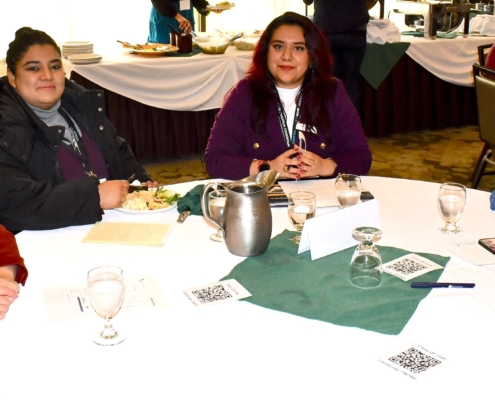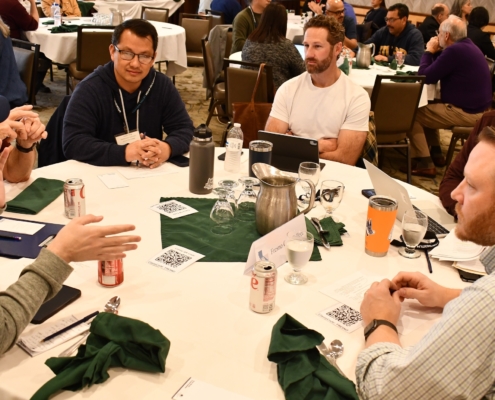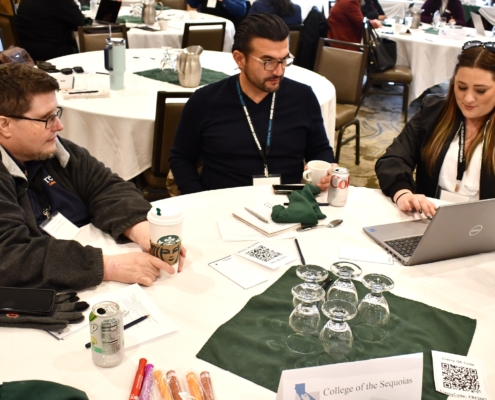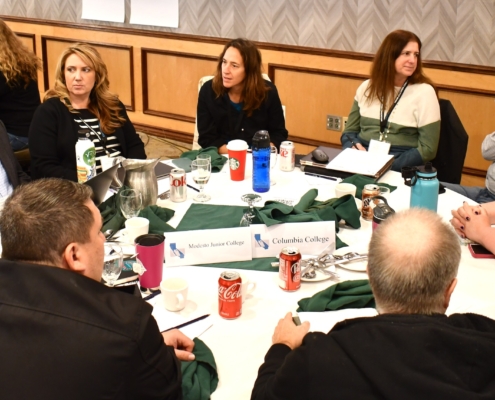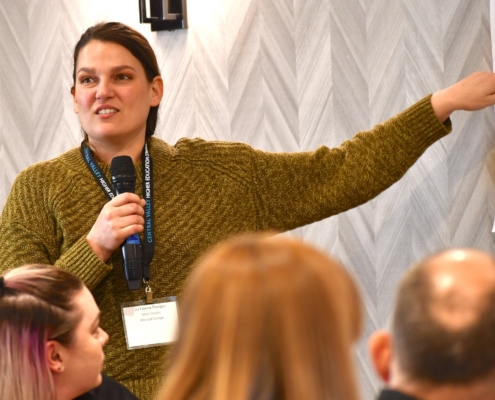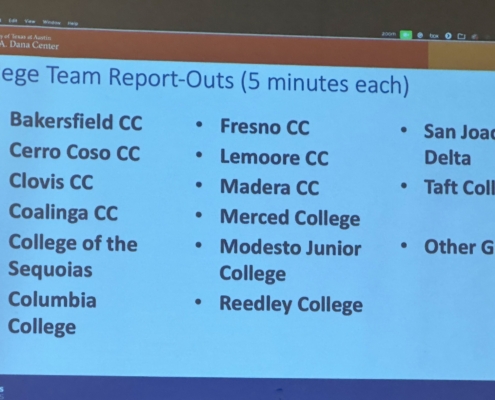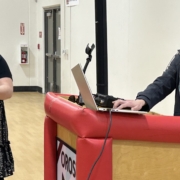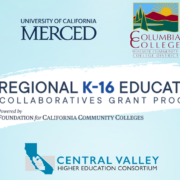MATH TASK FORCE: ‘Something extraordinary’ (Jan. 26 wrap)
Modesto Junior College math professor Tina Akers-Porter discusses her strand group’s deliberations at “The Central Valley Way to AB1705 Success” Convening Jan. 26 where a call for a “principals task force” by Orosi High School Principal Marlena Celaya would bring more secondary education voices to the table.
‘Something extraordinary is happening in math in California’s Central Valley’
Math Task Force latest AB1705 session leads to calls
for more data, high school input, re-convene April 19
BY TOM URIBES
CVHEC Media/Communications Coordinator
Realizing that state guidance surrounding Assembly Bill 1705 remains elusive, valley community college math educators and officials forged ahead at “The Central Valley Way to AB1705 Success” convening Jan. 26 in Fresno with a determined and unified mindset to develop implementation plans that will serve the best interests of their students including a follow-up session set for April.
In addition, the Central Valley Higher Education Consortium (CVHEC) Math Task Force discussion centered around five strands of curriculum planning for implementation before the law goes into effect July 1, two aspects emerged at the lively day-long work session: the increased participation of institutional researchers for pertinent data-collecting and a call for a “principal’s task force” to bring upper secondary education voices to the table.
Presented by CVHEC, the convening — the latest in a series of deliberations since fall — was attended by 82 representatives from the consortium’s 19-member community colleges, one high school principal and campus research professionals.
They agreed to reconvene April 19 for reports on follow-up work that will occur as a result of this most recent event. Registration for that event will open next month with additional details forthcoming.
Facilitated by the Charles A. Dana Center at the University of Texas at Austin, the session last month reviewed five strands of curriculum planning: Validating Prerequisites; Designing Precalculus for 2025; Math Support Outside and Inside the Classroom; Building an AB 1705 Campus Team; and Guided Self-Placement.
“With tensions high and little guidance surrounding AB1705, the 19 community colleges and districts that comprise the CVHEC nine-county region are rolling up their sleeves and getting to work on this math movement the ‘Central Valley Way’,” summarized Tammi Perez-Rice of the Dana Center.
Perez-Rice, who co-facilitated the event, said the convening was solely dedicated to working and planning at a regional and institutional level in two parts. The first part was dedicated to expanding the five work groups that emerged from the Nov. 17 webinar and creating a plan to move forward. The second half of the convening was devoted to institutional planning.
“The fruits produced from these convenings are already being felt around the region,” Perez-Rice said. “The plans and implementations emerging from these convenings are more than just a response to AB705 and AB1705; they cultivate systemic reforms that will benefit all students in the CVHEC region and beyond.”
John Spevak, CVHEC regional coordinator who oversees the consortium’s Math Task Force and co-facilitator of the Jan. 26 gathering, said in the short-term, the five strands work groups will continue to communicate and provide updates in preparation for the April 19 convening. The strand leads are preparing summaries of their Jan. 26 breakout discussions and member college teams are preparing summaries of the tentative plans they developed in the afternoon breakout sessions for oral reports in April.
“In the longer term, our Math Task Force will continue to monitor what the California Community College Chancellor’s Office says, while mainly going forward with our own Central Valley approach to the five strands.”
That “Central Valley Way” stems from the work undertaken by the CVHEC Math task Force, first formed in 2019, in the past year that was intensified with four work sessions beginning Oct. 6 in a virtual convening with CCC vice-chancellor Eric Cooper. The first in-person session followed Oct. 13 in Fresno and another virtual session was held in two parts Nov. 17 before the Jan. 26 session.
These sessions may represent the only concerted effort by a region’s community college math community actively meeting to collaborate across campus boundaries for ways to unite as one voice and determine a curriculum course of action that meets the law’s intent, Spevak said.
“We at CVHEC, along with the Dana Center representatives and our College Bridge partners in the Math Bridge Program, feel that something extraordinary is happening in math in the Central Valley of California,” Spevak said.
After the Jan. 26 session ended, Perez-Rice reiterated a point she made the first time she visited Fresno for the first in-person convening last fall:
“This collaboration today was amazing. As I travel and talk to math faculty all over the country, what I see pulsating from the CVHEC community here in Central California is just compassion; caring about their students; putting their students first; understanding what their students need; and more importantly collaborating with each other working across institutions to make things happen.”
Inviting secondary ed voices to ‘align syllabi’
A key development of the convening was the assertion and agreement that a crucial next step is “to involve high schools in the discussion and determine how to breakdown barriers between systems for a cohesive collaborative effort to put students first across the state of California,” a message delivered by Marlena Celaya, principal of Orosi High School who was the only secondary education official in attendance.
Celaya’s comments, first in a strand session and later in general comments before the assembled group, resonated with the community college professionals as she offered to lead a task force of principals/administrators who would unify with the CVHEC community college math educators for implementation strategy — to listen and hear what the needs are and how to meet those needs.
“I’m willing to lead this work because I don’t want people to go through the wars I went through teaching algebra and volunteering all my time,” said Celaya, a former math teacher at Dinuba High School. “We would want to hear from community colleges and say to them ‘what do you need?’
“We heard something from you today: ‘I want to know what courses are offered at the high school and what does that course description look like?’ Aligning syllabi is what I’d like to do,” Celaya said. “Mathematics is my passion.”
Perez-Rice said the April 19 convening promises more high school representation, with over twelve principals who are part of the Math Bridge Program by CVHEC and College Bridge being invited. Other secondary education officials from throughout the valley are welcome she said.
Participant feedback: ‘great to see we’re not alone in this …’
After the event, several participants shared their assessment of the Jan. 26 convening.
“The conversations were amazing and we really appreciated being here,” said Joshua Lewis, chair of the Bakersfield College Mathematics Dept.
“There have been so many legislative changes and so many unknowns it’s nice to see the work that other campuses are doing and realize that we’re not alone, that we have shared values; that we have shared emphasis on student learning and really care about doing right by all of our students,” he added.
Nathan Cahoon, Taft college math professor, felt that the efforts of CVHEC’s Math Task Force as exhibited at the convening is strengthening the voice of the valley’s math community which will have an impact.
“It was amazing to work with incredible professionals who have some really amazing ideas,” he said. “I know I took many good notes about ideas to implement at our college. The connections we are building here with each other will be powerful down the road as we build a cohesive effort to get some good research together that we can send to the state as one voice from all the colleges.”
Modesto Junior College math professor Marina Hernandez said coming together within the region is relished because when attending other statewide or national conferences, the focus is not as localized.
“It was very helpful to learn what other colleges in the Central Valley are doing because we share similar student population and resources characteristics and their best practices are applicable to us here in our region,” Hernandez said.
Tina Akers-Porter, Modesto Junior College math professor, said the Math Task Force work has helped her better understand what AB1705 is and what it means for her students.
“I feel like I have a better understanding of some of the challenges of the legislation and what others are worried about,” she said. “We share some of those worries but it’s great to hear different points of view on that. A byproduct of this is we are seeing how we need to support underprepared students more, inside and outside the classroom, and sharing ideas to do that.”
Shelly Getty, Taft college math faculty and a strand leader, echoed Akers-Porter: “We left knowing we are going to start some specific tutoring and targeting students for tutoring. We will try to advertise it better and recruit so students get more access to the services we already provide which will greatly impact them. We shared some good ideas on how to do that effectively.”
Marissa Martinez, Taft college math professor, said, “We have our work cut out for us. There’s a lot of things that we have to address with a lot of moving parts. Everything keeps changing but it was great to be able to see that we’re not alone in this, that we’re working together to better serve our students.”
She said this intercollegial collaboration and the feedback from the colleges helps “so we don’t have to reinvent the wheel — what worked, what didn’t work.”
Next steps? Data research
“I would say the next step is collecting our data to see how the numbers show where we are so we can prove that these courses are important for our student success,” Martinez said.
This data aspect was also a key part of the convening as institutional research professionals were invited and directly participated such as Arooj Rizvi, research analyst in the Office of Institutional research and Effectiveness at San Joaquin Delta College.
“Researchers have a monumental role in the implementation of AB 1705 because policymakers are going to depend a lot on what we are able to produce as a group or even as an institution,” Rizvi said. “Being a part of these conversations helps us to see the bigger picture, the context and the requirements of what exactly it is that we are looking for in the data.”
She said it was exciting to hear at the convening what area colleges are going through.
“I realized how similar our challenges are from institution to institution, “she said. “Working through that together and being solution-oriented is something that’s going to take all of us towards a beneficial direction. Seeing us all here today was a defining moment in history.”
Owynn Lancaster, vice president of academic strategy for CVHEC partner College Bridge, said the event was “a huge success seeing folks come together from math to talk about math and really pool their resources to address actual challenges.
“The most powerful focus of change in education is always the educator,” Lancaster said. “I know everything’s heaped on them but in a lot of ways they have the greatest power of the greatest agency for this.”
For more info: centralvalleyhec@gmail.com
For CVHEC media inquiries: Tom Uribes – cvheccommunications@mail.fresnostate.edu (or text 559.348.3278).
See also:
https://bit.ly/MTFconveneKSEE24
Valley’s math ed experts unite to address AB 1705 challenge for student success
The CVHEC Way to Math Success — Implementing AB1705
Math Task Force begins discussion of AB1705 implementation – Nov. 17 next
CVHEC Math Task Force meets in-person Oct. 13 for AB 1705 follow-up
NEWS RELEASE – CVHEC Math Task Force: Impactful legislation (AB 1705) Convenings Oct. 6 & 13
CVHEC Website Feature: Math Task Force Page
PHOTO GALLERY
MEMBER NEWS: North Valley, East Sierra CVHEC members partner for K-16 Collaboratives
State Planning Grants Could Lead to Expansion of CVHEC’s Dual Enrollment Initiatives
Two more Central Valley regions – North San Joaquin and Eastern Sierra – have each been awarded $250,000 state planning grants for the establishment of Regional K-16 Education Collaboratives Grant Programs as part of the statewide drive to strengthen the K-16 education-to-career pipeline. Both collaborative efforts are headed by Central Valley Higher Education Consortium member institutions.
The Department of General Services announced Nov. 9 that the state is awarding the planning grants to the two Central Valley regions as well as the Bay Area and the Central Coast for a total of $1 million. The one-year planning grants will help establish the collaboratives in those areas which will eventually seek additional funding to provide more streamlined, equitable pathways that can help local students transition from high school to college or career training and into the workforce.
In the Northern San Joaquin Region, the University of California, Merced is the lead agency for the newly formed North Valley tri-county Workforce and Education (WE Will!) Regional Collaborative that includes four other fellow CVHEC-members: Merced College, Modesto Junior College, San Joaquin Delta College and California State University, Stanislaus.
They are working in collaboration with partners from Merced, Stanislaus and San Joaquin counties through the WE Will! Collaborative.
For the Eastern Sierra Region, CVHEC-member Columbia College is heading up the K-16 collaborative planning along with several school districts, colleges and employer groups.
These partners will use the planning year to establish their collaborative and to apply together for up to $18 million in state funds available to the region for a three-year “cradle-to-career” pathway project.
These allocations amount to a total of four such collaboratives involving CVHEC members that will help bolster dual enrollment initiatives like the consortium’s successful Master’s Upskilling Program that has already been implemented in the mid valley region through the Fresno-Madera K-16 Collaborative and in the south valley area through the Kern K-16 Collaborative.
The program recruits and helps fund tuition for high school math and English teachers to earn a Master’s so they can teach dual enrollment courses in those subjects on the high school campus.
Dr. Benjamín Durán, CHVEC executive director, said the south and mid valley efforts have laid a solid foundation for the program to succeed when scaled and replicated in the North Valley and Eastern Sierra regions to better serve all Central Valley students.
“As we continue to equitably expand dual enrollment efforts in the Valley, we know one of the barriers for high school teachers to teach these classes is the lack of a master’s degree,” said Duran, president-emeritus of Merced College who was named to lead CVHEC in 2016. “With the new formation of both the WE Will! Regional Collaborative and the Eastern Sierra collaborative with this latest state funding, we will be able to expand our efforts throughout the Valley to increase dual enrollment opportunities for our students.”
In its announcement Nov. 7, UC Merced said the WE Will! Regional Collaborative – which was formed “to address streamlining and accelerating students preparing to enter the priority industry fields that would better serve our region, students and families” — will use the year to assess, design and create a work plan for the phase two application in the fall of 2023, which will be over $18 million.
“UC Merced is committed to helping break workforce barriers,” said Chancellor Juan Sánchez Muñoz who serves on the CVHEC Board of Directors that is made up of the presidents and chancellors of its 30 consortium members from San Joaquin to Kern counties.
“The WE Will! Collaborative between our campus and surrounding counties will be an essential pipeline to build a more equitable future for all students and provide the resources they need to reach their career goals,” the UCM chancellor said.
Dr. Ellen Junn, Stanislaus State president and CVHEC board member, said, “As the California State University serving this region, Stan State is committed to preparing our graduates to address and meet the needs of our regional workforce. We are dedicated to working collaboratively to aggressively pursue equity and diversity in degree and credential attainment as we work to ensure the best possible preparation for student success in the workforce.”
WE Will! provides collaboration between all education partners and the workforce to design ways for students to experience connected learning experiences, acceleration opportunities and successful transition into locally available careers.
“We know employers don’t stop at the county border when they are expanding,” said San Joaquin Delta President Lisa Aguilera Lawrenson, also a CVHEC board member. “We are looking forward to collaborating with our workforce partners and educational partners to get beyond the ‘border’ and plan for the region. Together we can provide a workforce for the needs of today and the future.”
The Eastern Sierra project will also include UC Merced and Stanislaus State as well as K-12, postsecondary, and industry partners, including the superintendents of schools in each participating county, several K-12 districts; and workforce investment boards, including Mother Lode Job Training. Those counties are Tuolumne, Calaveras, Amador, Mariposa, Alpine, Inyo and Mono.
“This is the first step toward a very exciting opportunity for our rural counties,” said Dr. Lena Tran, Columbia College president who is also on the CVHEC Board.
“We are very honored to serve as the lead for a project that will be designed specifically by and for our rural mountain communities. This planning year gives us a chance to build our collaborative and find what works for our students, our schools, and our employers.”
Earlier this year, the state awarded full implementation grants to the Central San Joaquin Valley and Kern County, as well as the North State, Redwood Coast, Orange County, Sacramento, Los Angeles, Border and Inland Empire regions totaling approximately $163 million.
The state grant was awarded through the 2021 Budget Act, which allocated $250 million to the Department of General Services and is being administered through the Foundation for California Community Colleges.
See the UC Merced press release (includes a full list of WE WILL partners) and Columbia College press release.
For CVHEC media inquiries contact Tom Uribes: tom@uribes.com (559.348.3278)
For UC Merced media inquiries, contact PIO Desiree Lopez: dlopez298@ucmerced.edu (209.746.5137)
Presenting our renovated CVHEC Website: Meet our Board of Directors
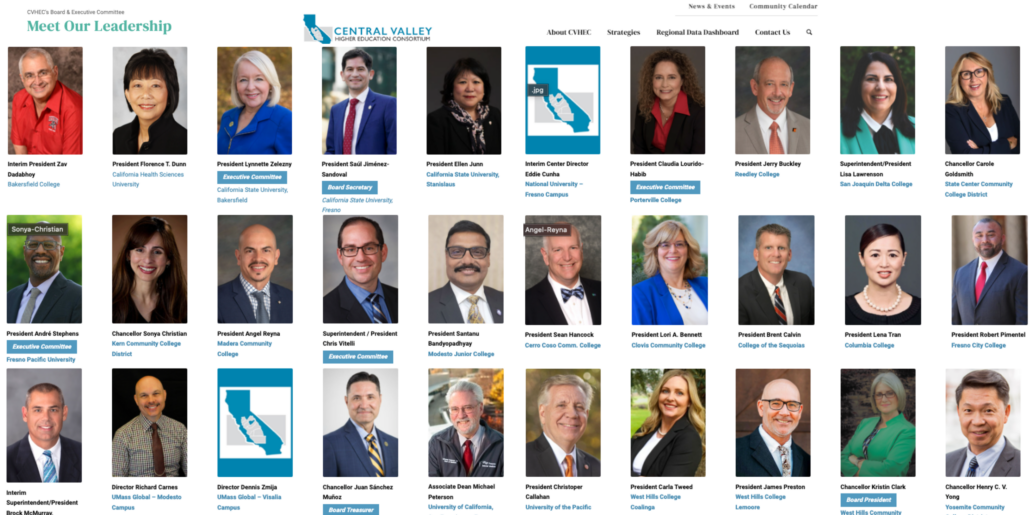
The chancellors, presidents and superintendents of 30 institutions of higher education in the Central Valley nine-county region from Stockton to Bakersfield sit on the CVHEC Board of Directors. They meet quarterly in pursuit of CVHEC’s core mission to increase valley college-going rates and degree/certification attainment, providing a unified voice for their more than 250,000 students served jointly. See the board of directors section in our newly renovated website: https://cvhec.org/about-cvhec/
This fall, we unveil phase one of our renovated Central Valley Higher Education Consortium website which we hope will be easier to navigate as we showcase the work of the Consortium throughout the valley.
We will be featuring a different piece of our website as we continue to build it out in hopes of showcasing it as a resource for our members, colleagues and partners.
This month, we feature the professionals and experts who are carrying out the CVHEC mission. On the “About CVHEC” page, you can meet our CVHEC Board of Directors – the presidents and chancellors of our 30 members of higher education in the Central Valley’s nine-county region from Stockton to Bakersfield as well as the core staff that includes several former educational leaders who now served as CVHEC regional coordinators/liasions,
Also, see our CVHEC News web page that is being finalized this fall featuring our newsletter stories and press releases where news media can connect with us as well as the members of our CVHEC PIO/Communicators Committee, consisting of the communications professionals handling media relations at each of the 30 campuses.
Our new calendar will keep you up-to-date on CVHEC and other higher education events on our radar. For considerations and modifications to our calendar please email centralvalleyhec@gmail.com.
Dr. Santanu Bandyopadhyay Named Modesto Junior College President
 Dr. Santanu Bandyopadhyay, named president of Modesto Junior College effective June 1, said growing enrollment and forging meaningful alliances with regional employers are among his immediate goals.
Dr. Santanu Bandyopadhyay, named president of Modesto Junior College effective June 1, said growing enrollment and forging meaningful alliances with regional employers are among his immediate goals.
The Yosemite Community College District Board of Trustees selected Bandyopadhyay, who was serving as interim president since January at its May 12 meeting. Previously, Bandyopadhyay had served as president of Columbia College in Tuolumne County, YCCD’s other institution, since July 2018 when also he joined the CVHEC Board of Directors.
Marking its centennial anniversary this fall, MJC serves about 22,000 students at MJC’s East and West campuses in Modesto.
President Bandyopadhyay takes over at a critical moment for California’s 16th-oldest community college as it focuses during its centennial on reconnecting with students after a year of mostly online learning forced by the COVID-19 pandemic.
“My short-term priority is to re-open the campus — paying particular attention to equity — build the enrollments we have lost during the pandemic, develop centers of excellence to cater to the need of our local businesses and ensure long-term fiscal stability,” he said.
“The effect of the pandemic was most severe on students who need us the most — therefore, an equity-focused recovery is critical for long- term economic growth of the region. Developing a deep connection with local businesses and partnering with them to understand and satisfy their needs in innovative ways continues to remain our priority.”
Bandyopadhyay has more than 23 years of experience in higher education. He was first the director of institutional research and planning and then as executive vice president Cypress College in Orange County. He also served at Zane State College in Ohio and Ohio University and taught computer science at theNational Institute of Information Technology.
In addition to his college administrative and teaching experience, Bandyopadhyay has been involved innational initiatives such as Achieving the Dream, Foundations of Excellence and Survey of Entering StudentEngagement.
Bandyopadhyay earned a doctorate in higher education from Ohio University, an M.B.A. from Ohio University and a bachelor of science in physics from Kolkata University in India.

